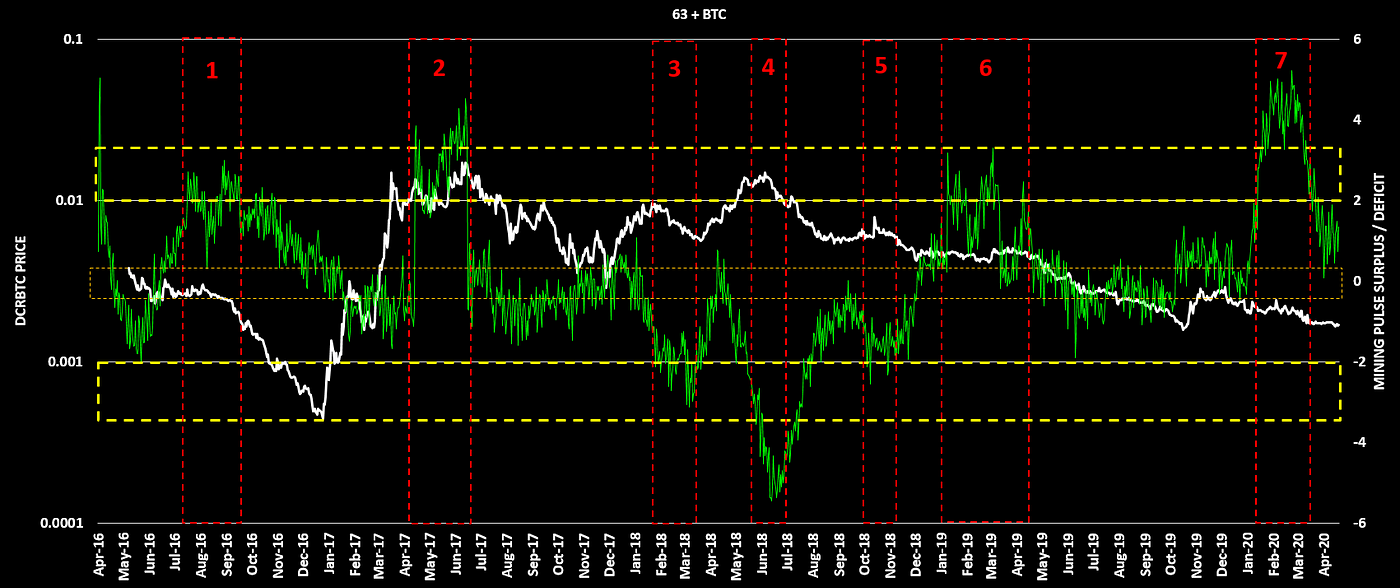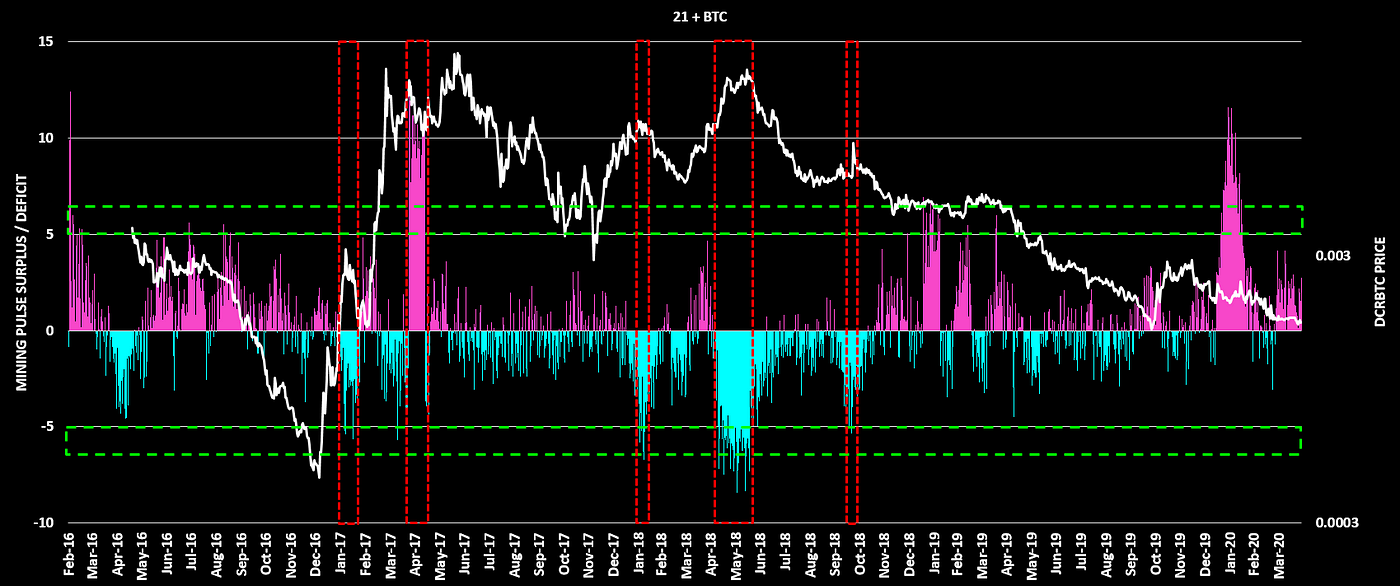Decred On-Chain: Mining Pulse
When performing on-chain analysis, it can be incredibly helpful to focus on patterns that repeat themselves time and time again. This logic is leveraged in the most popularly known on-chain indicators

By Permabull Nino - May 5, 2020 - An Exploration Into Block Times & Why They Matter

Introduction
Decred has three groups of network stakeholders who leave consistent, on-chain footprints:
- Contractors
- Stakers
- Miners
Each group’s on-chain footprint fluctuates / oscillates over time as a function of their share of block rewards earned (10%/30%/60% respectively) and financial needs (for example — selling DCR to pay bills). Crypto networks early in their lifecycles tend to have strong ties between (1) network value and (2) on-chain activity, as stakeholders are early adopters who are more comfortable transacting on-chain. Thus, their footprints tend to have higher signal when compared to larger crypto networks which have larger off-chain signatures.
The author’s previous explorations into Decred’s on-chain data have had a stronger focus on staking data, covering a healthy portion of the consistent, on-chain transactors. However — this has admittedly left a gap in the author’s understanding of the mining and contracting groups. This piece is a first attempt at scratching the mining itch, and will be explored with the following plan of attack:
- Why Look at Block Times?
- Mining Musings
- Decred Mining
- Mining Pulse
- Bitcoin Capitulations
- Conclusion
Why Look at Block Times?
The two primary reasons block times are a worthwhile point of focus surrounding mining are:
- Block times are natural oscillators
- Block times are the “final product” in mining data
Let’s briefly expand on these two points below…
Block Times are Natural Oscillators
When performing on-chain analysis, it can be incredibly helpful to focus on patterns that repeat themselves time and time again. This logic is leveraged in the most popularly known on-chain indicators, such as the NVT Ratio, the MVRV Ratio, and on a more mining specific note — the Puell Multiple. Top and bottom patterns in the same range provide high signal, simple ways for analysis and decision-making when combined with the proper historical context:
Block times fall right into this camp of repeating patterns, as they’re designed to oscillate within a certain range of the target block time. A look at the block times chart on Decred’s block explorer shows this quite clearly:
Another item worth pointing out about fractals (repeating patterns over time) is that when something usually moves predictably within a range, moves outside of that range are likely significant. Another look at the block times chart above will show that there are spikes upwards and downwards outside the predictable range — revealing points of possible volatility within the Decred mining ecosystem.
Block Times are the “Final Product” in Mining Data
There are four on-chain footprints that can be used to study mining behavior:
- Block rewards
- Difficulty
- Hashrate
- Block time
Each of the four footprints represent the following, respectively:
- Incentive
- Established standard / goal to receive reward
- Work put forth to accomplish goal
- Result, which is a function of previous three points
Miners are in many cases ideological, but above all else they’re profit motivated actors. Their number one goal is to maximize their bottom line i.e. earn the maximum amount of block rewards while minimizing their costs to do so. The way they earn these rewards is by discovering a hash below the network’s established difficulty target, which gives them the right to create a block. This newly created block includes a coinbase transaction which mints new coins to be sent to the address of the discovering miner’s choice.
Block times are a high signal tool because it gives on-chain onlookers a glance at the current state of the balancing act playing out between miners (profit motivated actors) and the network (which demands certain standards to be met before dealing out rewards). Instead of looking at each piece of the puzzle individually, we’re honing in on the result to truly understand what the big picture is. The next section will flesh out this thought process more thoroughly.
Mining Musings
There are a few topics addressed in this section:
- The idea that price leads, miners follow
- Understanding mild and extreme mining conditions, why the difference matters
Price Leads, Miners Follow
“Price leads, Miners Follow” in normal-speak translates to “Miners are top buyers and bottom sellers”. If we were to take the hashrate chart versus price, that would seem to be the easy conclusion — with run ups in hashrate until price corrects downwards, where hashrate corrects downwards in response. However, an argument can be made that this conclusion is misleading. Why? For the following reasons:
- Hashrate shows the unadjusted ability to produce blocks
- Block time shows the adjusted ability to produce blocks
Simply speaking — focusing on hashrate would be like measuring profit / loss in raw dollar terms, whereas % returns are what really matter. For this reason the author will argue and aim to substantiate such argument with evidence (based on the adjusted ability to produce blocks i.e. block times) that miners “buy bottoms and sell tops” as often as the reverse. More on this to follow in the charts / analysis section.
Understanding Mild and Extreme Mining Conditions, Why the Difference Matters
Establishing that block times represent the adjusted ability to produce blocks is important for our discussion surrounding mild and extreme mining conditions. With this in mind, there are three general states of mining:
- Periods where it’s relatively difficult to produce blocks (resulting in slow block times)
- Periods where it’s manageable to produce blocks (resulting in block times near target i.e. equilibrium mining)
- Periods where it’s relatively easy to produce blocks (resulting in fast block times)
Now, these three mining states have differing underlying mechanics, and thus affect miners / the market at large differently. These differences are shown in the table below:
A few items are worth fleshing out a bit more here:
- At the extremes (slow and fast block times), the end result is the same: miners get squeezed, which results in more coins being sold to maintain operations
- In the crypto space, people tend to obsess a bit over the slower block time squeezes, but generally overlook the other side of the coin. The author admittedly hadn’t thought much about the idea of miners weighing on price on the upside until Leo Zhang had written about it here
- Ideal mining conditions are the sweet spot in between, where mining cost and mining reward are at a healthy equilibrium
- Ideal mining conditions = Ideal price conditions
The discussion points in this section will be key in analyzing the Mining Pulse chart later on.
Decred Mining
The highlights of Decred mining, and that are relevant to block time analysis are as follows:
- Miners earn 60% of block rewards issued
- Difficulty adjusts every 144 blocks (~12 hours on average)
- Block rewards adjust downwards by a factor of 100/101 every 6,144 blocks (~21 days on average)
- ASICs were introduced mid-2018
- Target block times are 300 seconds (5 minutes)
For analytical purposes, the importance of these points respectively, are:
- Miners are the largest natural sellers within the network
- Difficulty adjusts frequently, thus making block time data very responsive and reliable for tracking trends
- Block reward adjustment period impacts miners’ bottom line, and this period will be used for analysis
- Expect temporary impact on block time data around mid-2018
- Target block time = baseline for analysis
Mining Pulse
The calculation for Mining Pulse is included below:
Mining Pulse calculates the three block reward cycle (63 day) average block time versus the target block time. Differences show a block time surplus / deficit, which means the following:
- Surplus: Three week average > target block time = slow block times
- Deficit: Three week average < target block time = fast block times
Furthermore — it’s important to note that block time will be herein measured in seconds, not minutes. Thus, any surplus / deficit tells users how many seconds the average is above / below the target block time (300 seconds) for the Decred network. Without further delay, here is the first look at the Mining Pulse chart:

Note that the DCRBTC price chart was used because it is the author’s opinion that it better gauges relative DCR price strength. The chart above shows the following:
- Miners weigh heavier on price at extremes, and this is reflected in the price action — with the Mining Pulse values of +/- 2 seconds nailing every major top since Decred’s genesis
- Price tends to trend during mild mining conditions (surplus / deficit around zero)
- Also note that DCRBTC bottoms have often occurred as the surplus / deficit approaches zero
- Decred recently experienced a capitulation-esque spike in block times
This final point isn’t trivial — reversion to the target block time has historically been a marker for trend change. With this in mind, let’s look at the Miner Pulse through a different lens — by turning the line that tracks the surplus / deficit into a bar chart:


The initial observation about reversions back to zero Mining Pulse surplus / deficit values are made quite clear in the charts above. As surplus / deficit values have thinned out, and eventually change color — DCRBTC & DCRUSD prices have changed trend historically. This not only makes the Mining Pulse a tool that (1) tracks extremes, but also a tool that (2) tracks trends over time.
The three block reward cycle average has the strongest combination of extremes and trend catching, but the one cycle average Mining Pulse can also be useful for accuracy in catching extremes in mining conditions:

Bitcoin Capitulations
Per the charts in the previous section, Decred miners recently capitulated in a big way — pushing Mining Pulse values to record highs. Decred is a young network, so there’s no precedent for understanding miner capitulations and the lingering effects following capitulation. As such, we will use Bitcoin’s block time chart to better understand what comes on the other side of capitulation from a mining perspective, how this likely impacts miners, and how it can reflect itself in price action:
Bitcoin is a different beast when it comes to mining, as it only adjusts difficulty every 2016 blocks (~2 weeks). This difference in mining design manifests itself in its Mining Pulse chart — with color flips from surplus to deficit (and viceversa) occurring less frequently than with what we see in Decred. Thus, our definition of “capitulation” differs — that being any instance where Mining Pulse prints a positive (purple / pink) value. With this in mind — Bitcoin has had three price capitulation bottoms (labeled 1, 2, & 3 in the chart) we can analyze and try to leverage into what may follow after Decred’s mining capitulation:
- Capitulation 1: Block time capitulation, followed by equilibrium mining (i.e. block times very near target block time), then price exits bottoming range
- Capitulation 2: Block time capitulation, followed by equilibrium mining, then price exits bottoming range
- Capitulation 3: Block time capitulation, followed by equilibrium mining, then price exits bottoming range
The capitulation trend for Bitcoin is consistent with analysis included earlier on: markets generally don’t bottom on miner capitulation, but rather on reaching a state of “equilibrium mining”:
The conditions that come with equilibrium mining provide minimum price gravity, and on this low gravity, price gets the opportunity to recover with the least amount of pushback possible.
Conclusion
Block times are a high signal means to track mining extremes and trends over time, and help give users a glance at the current state of mining without having deep subject matter expertise. Each cryptocurrency will have its own unique mining trend / extreme behaviors due to its own mining mechanics, which needs to be kept in mind for future comparative analysis between Decred and other coins. Furthermore, although (as of this piece) the author finds block times to be the highest signal means for tracking the Decred mining ecosystem, there are nuances specific to hashrate and difficulty that are worthy of further exploration.
Until then — signing out.





Comments ()